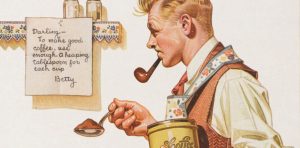The third of my articles for clothing brand House of Foxy’s menswear line 20th Century Chap published in February 2017.
This article is no longer online, so below is the original article in full.
Chap Talk: A peak in interest
I’ll bet when you reach for your suit or sports jacket from the wardrobe you never stop to think about why it looks the way it does. For example, why does it have a buttonhole in the lapel? Or why do we have different styles of lapel at all? Pretty tricky questions to answer to be honest.

To find out these answers, we have to travel back in time to the birth of that first great era for high fashion and style, the Restoration. After the collapse of the Commonweath and his restoration to the English throne, King Charles II decided that he would lead the fashion of the court into a new, worldly style, looking to the practical clothing of the east he’d seen on visiting dignitaries from Persia, such as Sir Robert Shipley. Interestingly, given the evolution of fashion is so organic, making specific dating hard to pinpoint, this is one of the few times a specific date can be placed on the introduction of a style, and an incredibly influential one at that, the date of this particular style shift was October 1666.

What Charles II did was to replace the doublet, ruff and hose, we know of from the Elizabethan period with an undershirt, waistcoat, coat (called a ‘Justacorps’), and breeches. By doing so, he created the very first descendant of the modern suit.
Whilst all of these items evolved in many ways, it’s the coat that changed the most. The original Justacorps was based on the traditional Persian Achkan, a long coat with a small stand collar (Charles’ version was collarless), buttoned all the way up the centre and with very distinct turned over cuffs on the sleeves. Over the next century the coats length shortened, the buttons stopped at the waist allowing for more movement of the skirt, the sleeves got tightened and were no longer folded back, but most importantly the coats started to have collars added.
It’s thanks to the evolution of another item of clothing synonymous with suits that pushed the Justacorps towards the more familiar jacket style we know of today, the introduction of the necktie (or to use the correct French word, “La Cravate” or Cravat).

As the cravat style became more flamboyant and elaborate, to literally create a ‘show’, so it meant that the opening around the top of the coat needed to be bigger, the logical conclusion of this was that it folded over, thus creating the lapel.
And it’s this function of a coat that means we get variations on lapel styles:
The notch is created because of the separate pieces of fabric used to create the front fold of the coat and the collar part. When the coat is closed the top portion of the collar is still folded over.
Now imagine if you increased the size of the front flaps of the coat so that it creates a double-line of buttons… that’s where the peak lapel comes from. It’s also the beginnings of the double-breasted jacket.

The shawl? Simply join the front flap of the coat to the collar in a continuous piece.
Of course this only makes sense looking back from a modern perspective, it wasn’t until the introduction of the less formal frock coat that coat lapels where pressed to always be open (unless needing to be closed to protect you from the weather).

It’s this original function of a lapel that leads us to still have a buttonhole, it’s simply so you can close your jacket all the way up. And people where doing just this all the way into the 1940s, as seen here sported by Cary Grant in The Philadelphia Story (1940):

By the way, did I happen to mention that we have both a notch and a peak lapel jacket coming soon to our British classics collection?
Keep your eyes peeled for an announcement in the coming months!




